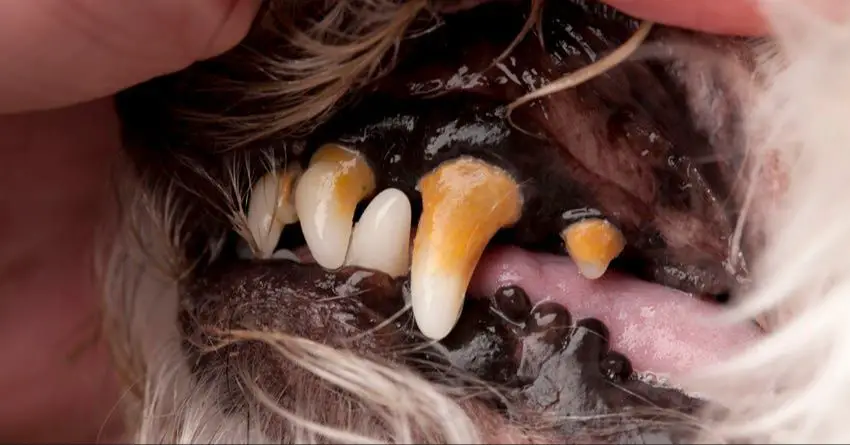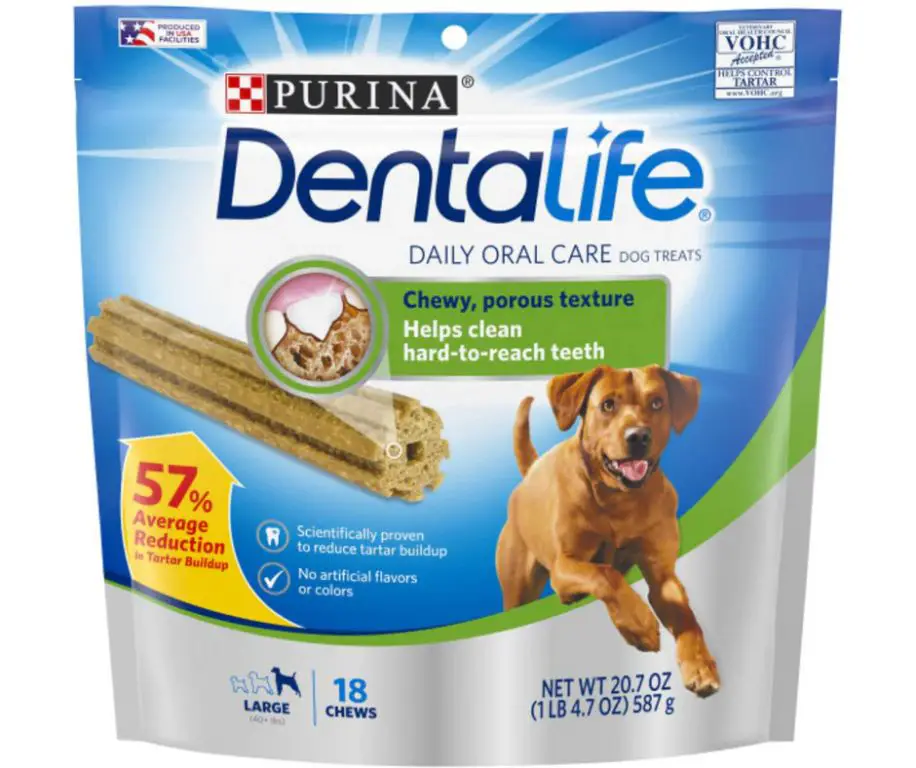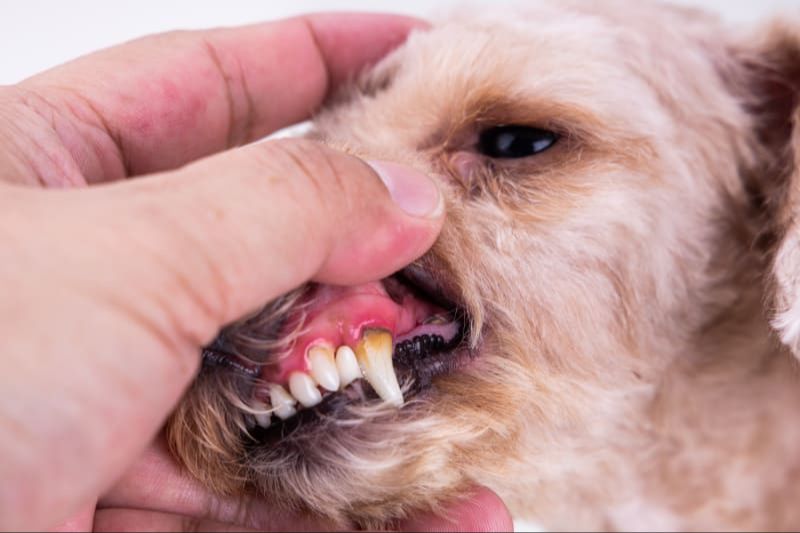What Causes Tartar Buildup on Dogs’ Teeth?
Tartar buildup on dogs’ teeth is caused by the natural bacteria present in their mouths. All dogs have bacteria in their oral cavity, which combines with food particles and saliva to form a sticky film called plaque on the surface of teeth. This plaque then undergoes calcification as minerals from the saliva harden it into tartar (also called calculus).
Over time, more and more tartar accumulates if it is not removed properly. The rate at which tartar builds up can vary a lot between individual dogs based on factors like their diet, breed tendency, and age. Harder, crunchy kibbles help scrub some plaque off, while soft, wet foods allow more plaque to stick. Smaller dogs like Yorkies are prone to more tartar buildup as they have crowded teeth. Older dogs also accumulate more tartar as they age.
Risks of Tartar Buildup
If tartar is allowed to build up on a dog’s teeth, it can lead to some serious health issues. The most common problem associated with excessive tartar is periodontal disease. This occurs when plaque and tartar accumulate along the gumline, leading to inflammation and infection of the gums and tooth roots. Periodontal disease is extremely common in dogs and can cause significant pain, tooth loss, and other oral health issues if left untreated.
In addition to periodontal disease, excessive tartar buildup can also lead to the loss of teeth. The tartar itself does not cause tooth loss, but the resulting gum infection and decay of the tissues surrounding the teeth will eventually cause them to loosen and fall out. This can be very painful for dogs and impair their ability to eat properly.
Overall, excessive tartar is a major cause of oral pain and discomfort in dogs. The edges of tartar deposits are rough and abrasive. They irritate the gums and underlying tooth structures. Dogs with a lot of tartar often show signs of mouth pain like decreased appetite and reluctance to eat hard foods or chew on toys.
Finally, the bacteria in tartar don’t just affect the mouth. The germs can enter the bloodstream through the infected gums and travel to other parts of the body, potentially leading to issues like heart, kidney, and liver disease. So keeping a dog’s teeth free of tartar is important for their overall systemic health and wellbeing.
Signs of Excessive Tartar
Excessive tartar buildup can be identified through several noticeable signs. The most obvious is yellow or brown deposits on the teeth. As plaque hardens into tartar, it becomes discolored over time. These stains will be most visible along the gumline and between teeth where tartar accumulates the most.

Bad breath is also a key indicator of too much tartar. The bacteria in plaque produce sulfur compounds that cause odor. The more plaque present, the worse a dog’s breath will smell. The breath may smell sweet or have a strong rotten smell if advanced dental disease is present.
Tartar buildup can also lead to inflamed gums. The gums might appear puffy or red rather than their normal pink color. Inflamed gums, known as gingivitis, can be painful and lead to further dental problems if left untreated. Severe gingivitis is usually accompanied by bleeding gums.
Finally, excessive tartar can result in loose or missing teeth. The buildup of plaque and tartar under the gumline causes periodontal disease. This erodes the tissues holding the teeth in place. Affected teeth will start to loosen and may even fall out if dental cleaning is not performed.
Professional Cleaning
The most effective way to remove tartar buildup on dogs’ teeth is to have them professionally cleaned by a veterinarian. This involves putting the dog under anesthesia and using specialized tools to scale and polish the teeth down to the surface. Any plaque and tartar is completely removed.
Professional teeth cleanings are the most thorough method of removing tartar, getting deep below the gumline and into the small spaces between teeth. However, the downside is that they require anesthesia and can be quite expensive, ranging from $300-500 depending on the vet clinic.
Most vets recommend getting a professional dental cleaning done annually if a dog has significant tartar buildup. While expensive, professional cleanings are very effective at removing tartar and plaque all the way down to the tooth surface and preventing further dental disease.
Regular Brushing
Brushing your dog’s teeth on a regular basis is an effective way to reduce tartar buildup. Brushing helps remove plaque before it hardens into tartar. It’s best to brush at least 2-3 times per week.

When brushing your dog’s teeth, use a soft brush designed for dogs. Don’t use a human toothbrush, which is too large. Special dog toothpaste should also be used, not human toothpaste. Dog toothpaste is formulated to be safe if swallowed. Look for a toothpaste that contains enzymes to help break down plaque and control tartar buildup.
Start slowly with brushing to get your dog accustomed to the process. Gently lift their lips to expose the teeth and brush with soft, circular motions. Make sure to brush both the front and back teeth. Give your dog praise and rewards to reinforce brushing as a positive experience.
Regular brushing can dramatically reduce tartar buildup on your dog’s teeth, keeping their mouth healthy and preventing more severe dental disease.
Dental Chews
Dental chews are treats made with abrasive ingredients that help scrape away tartar as the dog chews. The mechanical action helps remove plaque and tartar from the surfaces of the teeth.
Look for dental chews that carry the VOHC (Veterinary Oral Health Council) seal of approval. The VOHC is an organization that reviews dental products for effectiveness and safety. Their seal means the product has gone through rigorous testing and shown proven tartar control.
Some ingredients to look for in VOHC approved dental chews include delmopinol, sodium tripolyphosphate, hexametaphosphate, and psyllium. These have been shown to actively fight plaque and tartar when chewed over time.
Offer dental chews daily, ideally right after meals when saliva production is high. The saliva helps the chews penetrate the plaque and soften it for removal. This makes the chews more effective at scraping away tartar buildup on the tooth surfaces.
Dental Diets

A dental diet for dogs can help remove tartar by meeting their nutritional needs with kibble that has specific tartar control properties.
Typically, dry kibble formulated for dental health will be textured in a way that gently scrubs and scrapes away tartar. Some feature a larger and harder kibble or kibble with shapes that act as teeth scrubbers. Others have fiber sources, like rice bran, that are designed to provide a gentle abrasion.
These dental diets will also contain additives that help prevent tartar, including compounds that bind minerals like calcium and phosphorous that contribute to tartar buildup. Some dental foods have enzymes like lactoferrin that help inhibit bacteria growth contributing to plaque. Taurine and beta carotene may be added for their antioxidant benefits in supporting gum health.
Drinking Water Additives
One option to help control tartar on your dog’s teeth is adding an antimicrobial or enzymatic supplement to their drinking water. These types of additives can make the water itself a tool for reducing plaque and tartar buildup.
Antimicrobial ingredients like chlorhexidine work by inhibiting the bacteria in your dog’s mouth that contribute to plaque formation. With less plaque, there is less chance for tartar and calculus to accumulate on the tooth surface.
Enzymatic additives like lactoperoxidase, glucose oxidase, and lactoferrin help break down plaque and tartar that has already formed. They work by interfering with the plaque matrix, causing it to dissolve more easily when your dog drinks.
Water additives are convenient since your dog will ingest them passively when drinking throughout the day. Make sure to follow dosing instructions carefully. While generally safe, some dogs may have sensitivities to ingredients like chlorhexidine. Checking with your vet is advised, especially if your dog has health conditions.
Other Tartar Control Options
In addition to regular brushing, dental chews, and dental diets, there are some other tartar control options to help remove and prevent the buildup of tartar on your dog’s teeth:
Dental gels and wipes – These products allow you to wipe your dog’s teeth to help remove plaque and tartar. The gels and wipes contain ingredients like hydrogen peroxide, baking soda, enzymes, aloe vera, and antiseptics to help break down tartar. They are easy to apply to your dog’s teeth daily.
Water additives – You can add dental solutions to your dog’s drinking water that help reduce tartar. They contain ingredients like zinc chloride, sodium hexametaphosphate, or delmopinol to help prevent plaque and tartar.
Antiseptic rinses – There are antiseptic dog rinses that can be applied after brushing to help kill bacteria, prevent plaque buildup and reduce bad breath. The antiseptics in the rinse help fight plaque and tartar.
When to See the Vet
Excessive tartar buildup can lead to some concerning signs that indicate it’s time to take your dog to the vet. If you notice any signs of discomfort like loose teeth or red and inflamed gums, a vet visit is likely needed. Tartar buildup can also make it difficult for dogs to eat if it builds up significantly on their teeth and gums. In those cases, a professional dental cleaning by your vet is required.

Some specific signs that it’s time to take your dog to the vet for their teeth include:
- Bad breath that doesn’t improve with brushing
- Red, swollen, or bleeding gums
- Yellow-brown tartar buildup on the teeth
- Loose or missing teeth
- Difficulty eating or chewing
- Pawing at the mouth
- Drooling
Routine dental cleanings, usually once a year, are important for dogs prone to tartar buildup. The vet will scale and polish the teeth to remove all built-up tartar. They may also take dental x-rays to check for issues below the gumline. A professional veterinary dental cleaning is the most effective way to remove heavy tartar and keep your dog’s teeth and gums healthy.